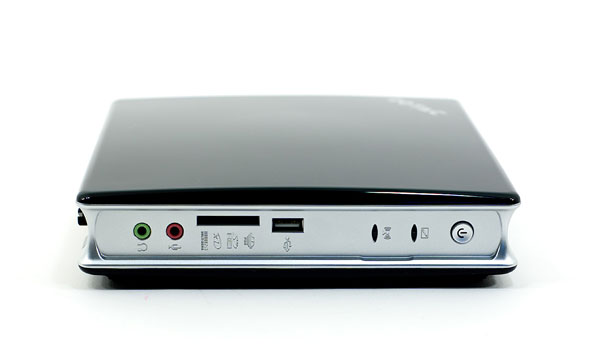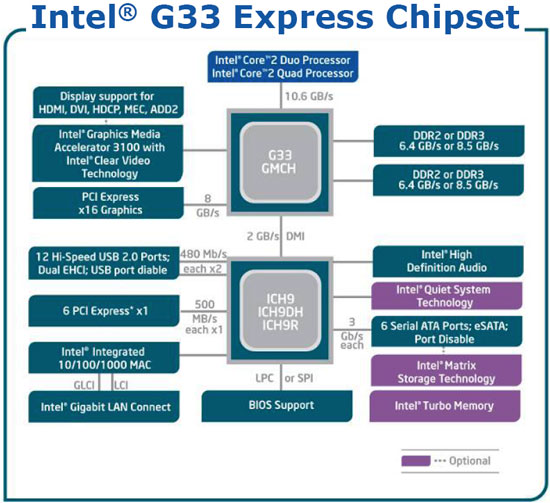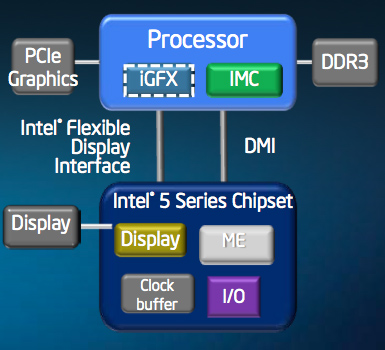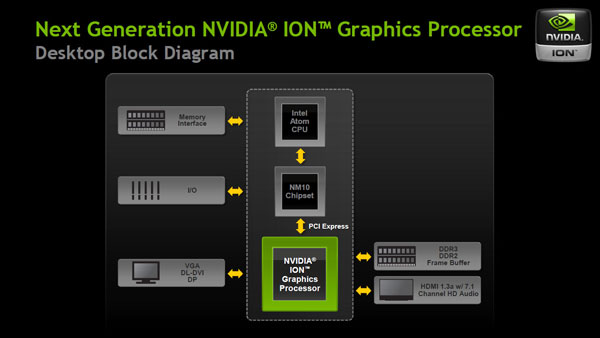Zotac ZBOX HD-ID11 Review: Next Gen ION is Better & Worse than ION1
by Anand Lal Shimpi on May 6, 2010 3:51 PM EST- Posted in
- GPUs
- Next Generation ION
- HD-ID11
- ZOTAC
- NVIDIA
The nForce 2 was one of the best chipsets to come out of NVIDIA. It was NVIDIA’s second attempt at a desktop chipset yet it cemented NVIDIA’s position as a leading provider of core logic in the market. Oh how much has changed since then.
Most of what made a chipset worthwhile is now integrated into the CPU. It used to be memory controller optimizations that kept chipsets afloat, but that’s no longer the case as all x86 processors now ship with an integrated memory controller. The performance differences between chipsets disappeared and all that was left was testing, validation and drivers, also known as the boring, expensive and time consuming aspects of chipset development.
NVIDIA has mostly abandoned the chipset business, focusing on opportunistic wins where possible. The most obvious example is with ION, its chipset/GPU for Atom based systems.

Last year we played with a number of ION systems and motherboards and were generally impressed. The platform made for a powerful little HTPC. Today we’re able to bring you a hands on performance preview of the first Next Generation ION box we’ve laid our hands on: the Zotac ZBOX HD-ID11.
Terms of Ndearment
CPUs connect to the outside world using proprietary bus interfaces. AMD uses Hyper Transport, while Intel previously used the AGTL+ FSB. In order to build a device that hangs off of this interface you need a license to use it. This is just an IP license to let you integrate the circuitry you need to communicate over that bus onto your silicon. It’s pretty commonplace.
Over the years Intel would update its FSB (Front Side Bus) specification, and it would threaten its chipset partners with revoking their license to the new version of the FSB unless they cooperated. Intel and VIA had a disagreement over this years ago that ended in VIA threatening Intel with CPU patents and the two coming to terms later on.

The old way of doing things, FSB between the CPU and the GMCH, DMI between the GMCH and ICH.
With Nehalem, Intel moved away from a parallel bus interface and introduced QPI (Quick Path Interconnect). This is a very high bandwidth point to point protocol designed for high end servers, workstations and desktops. It’s used in the Nehalem and Gulftown based Core i7s. NVIDIA said it had no interest in pursuing a QPI based chipset, so the issue of licensing never came up.

The new way, QPI between the CPU and IOH. DMI between the IOH and ICH.
A much lower bandwidth interconnect called DMI (Direct Media Interface) would be used for mainstream Nehalem/Westmere derivatives (e.g. Core i3, Core i5, LGA-1156 Core i7). Intel had used this interconnect in the past to connect parts of its chipsets together, but now it would be used to connect the CPU to a chipset.

The other new way: DMI between the CPU and chipset.
With its own aspirations of getting into the GPU market, and no real need for NVIDIA’s allegiance, Intel enforced its license agreement and threatened a lawsuit if NVIDIA sold chipsets that used Intel’s DMI. NVIDIA argued that it was well within its rights to do so but didn’t want to risk it and stopped development on DMI chipsets pending the outcome of its lawsuit against Intel for violating the terms of the license agreement.
The ION Problem
While all of this was going on, Intel’s Atom platform started gaining momentum in netbooks and nettops. The netbook version of Atom used the old AGTL+ FSB to connect to its chipset, so NVIDIA could technically produce chipsets for it. Which is exactly what NVIDIA did. It was called ION (and later renamed to Atom + ION).
The latest version of Atom for netbooks/nettops, codenamed Pineview, integrates the memory controller and graphics core. Its only connection to the outside world is, you guessed it, a DMI link.

In a Pine Trail Atom system, the Pineview CPU connects to Intel’s NM10 Express chipset over this DMI link. With no license for DMI and no desire to push its luck, NVIDIA can’t offer a drop in replacement for the NM10 Express chipset.
Luckily, Intel’s NM10 Express Chipset includes four PCIe 1.0 lanes. A motherboard manufacturer could simply hang a low end, discrete GPU off of these PCIe lanes and you’d get a modern ION platform. And that’s what NVIDIA did for its Next Generation ION.
Meet NG-ION
NVIDIA’s Next Generation ION is a 40nm discrete GPU based on the GT218 core, it’s effectively the same GPU as a desktop GeForce 210 video card with some differing clock speeds. The nettop version uses 16 cores, while the netbook version uses 8 or 16 depending on the screen size.
While manufacturers can use all four PCIe 1.0 lanes coming off Intel’s NM10 Express chipset, most have chosen to use just one leaving the remaining lanes for things like WiFi. A single PCIe 1.0 lane can only provide 250MB/s of bandwidth in either direction, hardly enough for a modern GPU. It’s because of this limitation that the next-generation ION GPU could actually perform slower than the first ION.

As a discrete GPU, the NG-ION comes with its own frame buffer: up to 512MB of DDR3 on a nettop. You also get full H.264 video decode acceleration and support for 8-channel LPCM audio over HDMI out.















40 Comments
View All Comments
Swivelguy2 - Thursday, May 6, 2010 - link
A little typo right up in the title: "Next Gen is ION" should say "Next Gen ION is"shotage - Thursday, May 6, 2010 - link
I've been waiting for one of these to hook up to my HD TV. This looks near perfect, but the fact the flash playback sucks is going to make me wait. If Nvidia can fix it with an updated driver i'm off to the shop. Otherwise I'll be back... to curse Zotacjvdb - Thursday, May 6, 2010 - link
They raised the price again? if it's true, I'll wait for the shuttle.Roy2001 - Thursday, May 6, 2010 - link
I need to point out that Broadcom Crystal HD decoder has a 40Mbps limitation and Ion does not have. XBMC would report dropped frames with higher than 40Mbps bitrate. That said, BD spec is less than 40Mbps and you can hardly see > 40Mbps mkv files. But I have seen that. Even XBMC with CPU decoding has the 40Mbps limitation and drops frames with CPU utilization less than 70%.sucram03 - Thursday, May 6, 2010 - link
You've seen >40mbps encoded MKV's? Whoever encoded them must have done a horrible job if they're at 1080p. Nothing should have to be encoded with that high of a bitrate -- that's overkill.A 40mbps limitation shouldn't be a problem. One thing that isn't touched on here, though, is CUDA-enabled decoding, which removes pretty much all limitations on H.264 content when done with DXVA. With CoreAVC 2.0, you'll pretty much never have a file you can't play. That would be the nice thing about this new ION, being that it has VP4 PureVideo. But.. as some have already said, this platform is way too expensive for that usefulness.
mcnabney - Thursday, May 6, 2010 - link
I have the original Zotac ION HTPC and am relatively pleased with it. Added more RAM and upgrade XP to 7. The memory upgrade made it run much more quickly and moving to Win7 allowed Mediacenter usage (it is a DVR for an HDHomerun and recorded TV is automatically moved to my WHS box).Old ION $200 @ Best Buy
Win7 upgrade $50
Upgrade to 2GB $40
So under $300 complete.
compare to:
New ION $250
HDD/SSD $80
Win7 OEM $100
Now we are at $430 when complete. That is a LOT more money for almost identical performance.
Bateluer - Friday, May 7, 2010 - link
This is a poor comparison. The 200 dollar Ion system the Acer Revo R1600, is an Atom 230 based machine. Single core. The new Ion featured in the review is a D510, dual core machine. Performance won't be light years better by any means, but this isn't a good comparison.Still, if you already have an Atom 330 Ion system, there's no need to pick up one of these machines unless you have money to burn. Like the Pine Trial platform itself, NG-Ion falls flat.
mcnabney - Tuesday, May 11, 2010 - link
Why wouldn't it be a good comparison? Under the tests that the new ION does surpass the old (would more memory help the old one?) the difference is moving from 49% of the performance of a slow Core2 to 53%. So there is really a very slight difference in performance. But there is a very clear difference in cost. In fact, the original Zotac ION can be purchased for $170 now.sucram03 - Tuesday, May 11, 2010 - link
You missed the point of the poster. The comparison you're making is between ION2 and the original ION with Atom 330 processor (note the difference -- this is dual-core). The $199 desktop at Best Buy is an Aspire Revo1600, as the poster said, which does NOT have an Atom 330 dual-core, it has a single-core Atom 230. If you want to talk about performance, go ahead and take a look at the benchmarks again, instead now looking at that last-place ranking with the Atom 230 processor which falls short in every benchmark. Not by a huge margin, but enough to make a significant impact, which is exactly what that poster was trying to say.It was a very valid argument. Just make sure you're backing up your claims with solid proof, links, or other general information instead of throwing together $'s and manipulating the outcome.
shotage - Thursday, May 6, 2010 - link
This quote "Streaming high definition Internet video on popular sites such as YouTube™, Vimeo™ and Hulu™ render smoothly and flawlessly in full screen with the ZOTAC ZBOX HD-ID11 and Adobe® Flash® Player 10.1. Video stuttering is a faint thought of the past with the ZOTAC ZBOX HD-ID11 with NVIDIA® ION™ graphics technology."from Zotacs site: http://zotac.com/index.php?option=com_content&...
Obviously this is incorrect. Anand; maybe someone should tell Zotac? :p